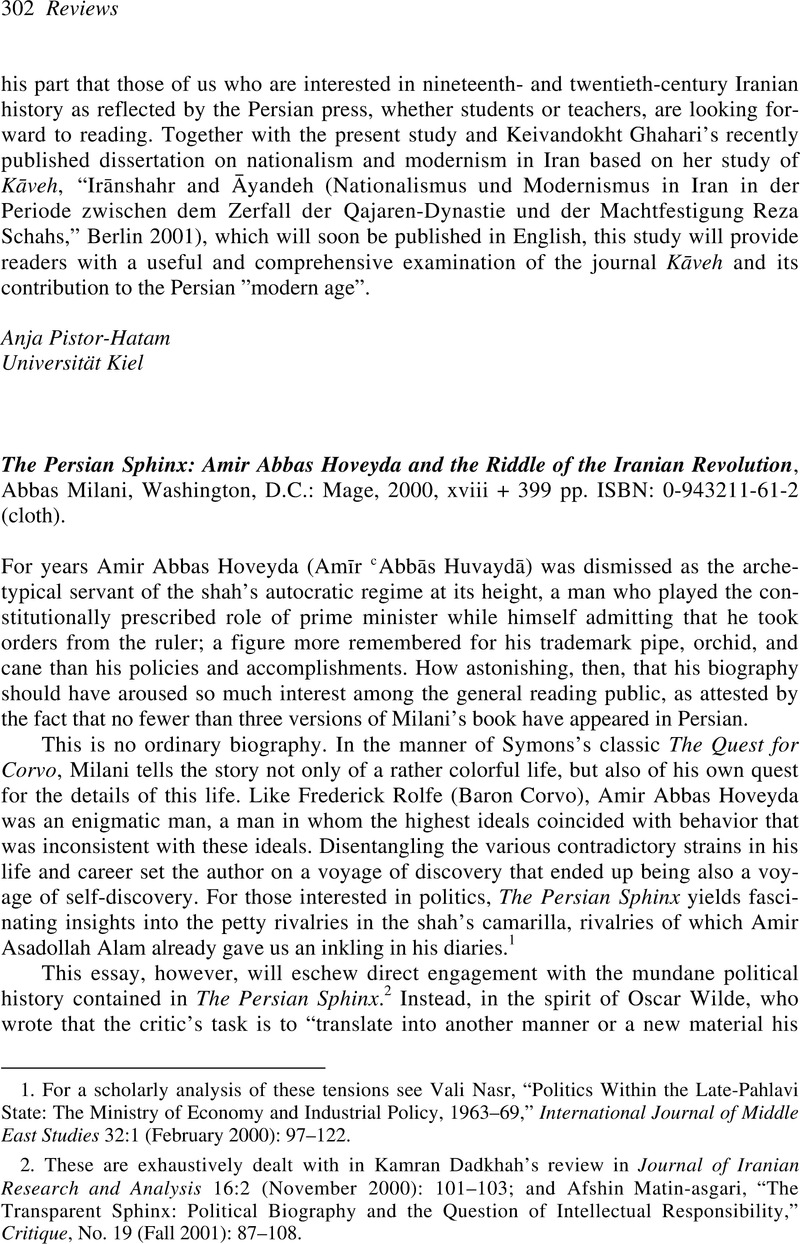No CrossRef data available.
Published online by Cambridge University Press: 01 January 2022

1. For a scholarly analysis of these tensions see Nasr, Vali “Politics Within the Late-Pahlavi State: The Ministry of Economy and Industrial Policy, 1963–69,” International Journal of Middle East Studies 32:1 (February 2000): 97–122.CrossRefGoogle Scholar
2. These are exhaustively dealt with in Kamran Dadkhah's review in Journal of Iranian Research and Analysis 16:2 (November 2000): 101–103Google Scholar; and Matin-asgari, Afshin “The Transparent Sphinx: Political Biography and the Question of Intellectual Responsibility,” Critique, No. 19 (Fall 2001): 87–108.Google Scholar
3. In the “Preface” to The Picture of Dorian Gray.
4. Given the wide range of Hoveyda's reading, one is never quite sure to what an extent his life imitated art. For example, how can the scene where, traveling to Europe by boat, the smell of bifteck frites makes him feel that he is already in France (65) not remind the reader of the famous passage in J.-K. Huysman's A Rebours (available in English in two translations under the titles of Against Nature and Against the Grain), where the novel's hero, the Duc des Esseintes, before crossing the English Channel, eats at a restaurant near the Gare St. Lazare and finds that his roast beef reminds him so much of England that he no longer needs to undertake the trip, having already experienced the sensation of being on the other side of the La Manche?
5. The first theoretical study on dandyism was Jules Barbey d’Aurevilly's 1844 essay Du dandysme et George Brummell, inspired by the most famous of all dandies, George (“Beau”) Brummell. For an English translation of this seminal work see Dandyism, translated by Douglas Ainslie, (New York, 1988). This was followed in 1863 by Charles Baudelaire's essay “Le Dandy,” part 9 of his “Le peintre de la vie moderne.” The present essay will quote from the English translation: Baudelaire, Charles “The Painter of Modern Life,” in The Painter of Modern Life and Other Essays, translated and edited by Mayne, Jonathan (New York, 1986).Google Scholar More recent theoretical works on dandyism include Mann, Otto Der Dandy: Ein Kulturproblem der Moderne (Heidelberg, 1962)Google Scholar; Coblence, Françoise Le dandysme, obligation d’incertitude (Paris, 1988)CrossRefGoogle Scholar; and Natta, Marie-Christine La grandeur sans convictions: essai sur le dandysme (Paris, 1991).Google Scholar The best historical study is Moers, Ellen The Dandy: Brummell to Beerbohm (Lincoln, Neb., 1978).Google Scholar For the literary aspects see Lemaire, Michel Le dandysme de Baudelaire à Mallarmé (Montreal, 1978)Google Scholar; Gnüg, Hiltrud Kult der Kälte: Der klassische Dandy im Spiegel der Weltliteratur (Stuttgart, 1988)CrossRefGoogle Scholar; and Feldman, Jessica R. Gender on the Divide: the Dandy in Modernist Literature (Ithaca, 1993).Google Scholar For an attempt at Freudian analysis of the dandy see Chervet, Bernard “Dandysme et confection de fétiche ou comment habiller un vide,” Revue Française de Psychanalyse 58 (April–June 1994).CrossRefGoogle Scholar
6. d’Aurevilly, Barbey Dandyism, 23.Google Scholar
7. Turner, Victor The Ritual Process: Structure and Anti-Structure (Ithaca, 1977), 95.Google Scholar
8. Curiously enough the literature on dandyism has so far overlooked the figure of Clapique. A connection is hinted at in Delbourg-Delphis, Marylène Masculin Singulier (Paris, 1985), 95.Google Scholar
9. See footnote 5.
10. For an analysis of Disraeli's dandyhood see Moers, The Dandy: Brummell to Beerbohm, pp. 84–104Google Scholar; and Coblence, Françoise “Disraëli: du style dandy en politique,” Critique 405–406 (FebruaryMarch 1981): 276–99.Google Scholar
11. See Meijer, Roel ed., Cosmopolitanism, Identity and Authenticity in the Middle East (London, 1999).Google Scholar
12. See Bayart, Jean-François L’illusion identitaire (Paris, 1996), 85–92.Google Scholar
13. See EIr, s.v. “Freemasonry III. In the Pahlavi Period,” 216.
14. Marylène Delbourg-Delphis, Masculin singulier.
15. Baudelaire, “The Painter of Modern Life,” 27.
16. Perhaps this orchid was the fetish that masked the void, to adopt the central thesis of Bernard Chervet (see footnote 5).
17. Baudelaire, “The Painter of Modern Life,” 27. Emphasis in the original. For an elaboration on this theme of simplicity see Coblence, Le dandysme, 115–20.
18. Baudelaire, “The Painter of Modern Life,” 28.
19. Which is of course reminiscent of the most famous dandy of Spanish literature, the Marqués de Bradomín, who also told off-color jokes at the court of the Carlist pretender, as told by Ramón María del Valle Inclán in his Sonata de invierno (Winter Sonata).
20. Baudelaire, “The Painter of Modern Life,” 28. Of course Baudelaire uses “democracy” in its Tocquevillean sense of status equality.
21. See EIr, s.v. “Class System VI: Classes in the Pahlavi Period,” 678–79, for data on how this was reflected among members of parliament (if one can call centrally appointed members of parliament a political elite!).
22. For a discussion of the dandy's insolence see Coblence, Le dandysme, 82–89.
23. Unless one were to take his obsequious fawning before the shah au second degré, for which, however, there is no evidence.
24. The same holds true for his masonry, for in Europe freemasonry has historically opposed despotism rather than serve it.